 |
 |
 |
 |
 |
 |
|
Home page About us Instruction Guiding Locations map Gift vouchers Prices Articles Contact us Accommodation Links |
 Evolution of the wet fly: From drowned insect
to
'emerger' Evolution of the wet fly: From drowned insect
to
'emerger'This page explores how wet flies have changed over the last 150 years so that they now:
The page concludes with some speculations on the reasons why trout take artificial flies. These ideas are drawn from Paul's earlier academic career which involved research into the stimuli involved in controlling sequences of animal behaviour. |
- these old flies are still effective despite the fact that we now know that very few ephemeroptera hatch from nymph to winged adult beneath the water surface
- often fished with the 'across and downstream' or 'downstream-swing' technique
- unclear what they represented (cripples, drowned spinners?) and therefore they fell out of widespread use
- but modern insights into the egg-laying behaviour of some female caddis (see below) may explain their effectiveness and restore their popularity
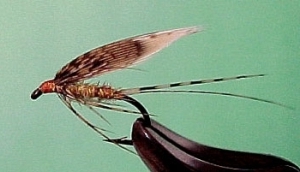
Winged wet fly: March Brown (tied by Jeff Serena)

March Brown: Rithrogena germanica. Note the similarity betwen the hatched natural and artificial flies
- often called 'soft hackled wet flies'
- may represent emergers, cripples or drowned spinners
- developed in northern England and southern Scotland (1857-1916)
- very sparsely dressed - short thin body of silk, one or two turns of hackle
- fished with short line upstream and a dead-drift, or with a downstream-swing
- remain an effective style of fly pattern
- modern revival prompted by Sylvester Neme's book "The Soft Hackled Fly" published in 1975
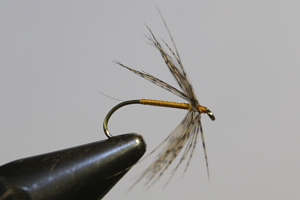
Partridge and Orange. Note thin short body made of tying silk and sparse (1-2 turns) hackle.
- introduced (1921-1939) by Skues for use on chalk streams - relatively clear and slow-flowing rivers
- incorporate a distinct dark coloured thorax to represent wing cases
- unweighted flies fished across and upstream just beneath the surface with minimal movement - dead-drift
- Skues targeted trout showing 'bulging' rises to pre-emergent nymphs prior to a hatch
- can be difficult to detect the take unless water surface is relatively smooth
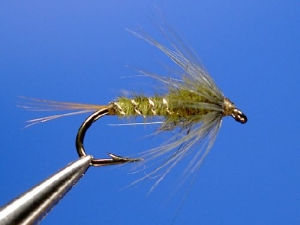
Medium Olive Nymph (Skues)
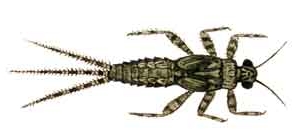
Ephemerella ignita: Blue Winged Olive nymph
Note the thin body and distinct thorax just behind the head of the natural insect which is reproduced in the artificial fly
- Skue's method developed further by Frank Sawyer who introduced the weighted Pheasant Tail nymph which was dead-drifted and also moved to provoke an 'induced take'
- method developed for catching trout that are often visible in clear chalkstreams
- nymph cast upstream of trout so it sinks to trout's level
- then rod tip is lifted - the 'induced take' technique

Pheasant tail nymph, tied with copper wire (Sawyer)
- term 'flymph' describes the transitional hatching stage between nymph (or pupa) and dun or adult insect
- introduced (1941-1979) by Hidy and Leisenring - influenced by Skues, called "the American Skues"
- fished throughout water column with movement e.g. the 'Leisenring lift'
- shaggy body materials trap gas bubbles - may mimic gas bubbles trapped beneath exoskeleton of pupa and nymph that facilitate ascent and eclosion
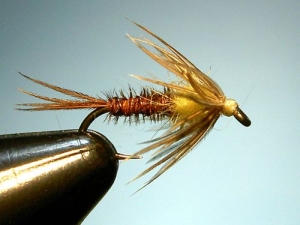 Transition
Flymph
(McGee )
Transition
Flymph
(McGee )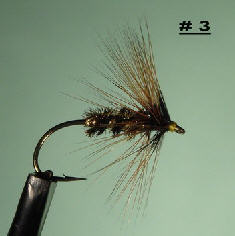
In 1863 - when North Country writers were advocating thinly dressed flies such as the Partridge and Orange (see above) - the West Country author Cutcliffe advocated hackled wingless wet flies. Note similarity in bushy body and hackle to modern flymphs
- Advances in macro photography enable us to study insect metamorphosis in great detail at each stage of the life cycle
- Advances in our understanding of animal behaviour reveal that artificial trout flies are probably effective because they incorporate 'trigger' elements found in the natural insect
- The law of heterogeneous summation could explain how incorporating several 'triggers' into an artificial fly increases its attractiveness to trout. In fact, the law suggests that these artificial flies could be more attractive to trout than the natural insects they are supposed to represent
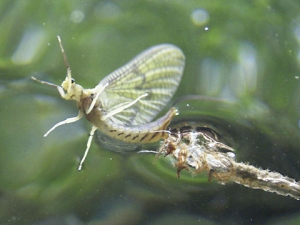
Mayfly dun shedding
its nymphal
shuck.

The Sparkle Dun (Craig Mathews) . Note how well the tail represents the nymphal shuck
- Bob Wyatts Deer Hair Emerger is probably the first conscious attempt to design a trout fly based on what ethologists / behavioural ecologists call 'sign stimuli'. According to Wyatt:
"Borrowing the
essential
features of Fran Better’s Haystack and Usual, Al
Caucci’s ComparaDun, and Hans van Klinken’s
Klinkhamer Special, the DHE is designed to present a strong
prey-image. It incorporates a couple of primary stimuli, or
‘triggers’: a visible wing and a sunk abdomen. While
suggesting natural aspects of the insect, these exaggerated
features ensure that the fly will be noticed - what behavioral
ecologists call a super-normal stimulus."
- This article explores the application of ethology to the design of trout flies

Deer Hair Emerger (Wyatt)

Paul relies on these ideas to explain-away his lack of fly-tying skills!
- Photographs of aquatic insects (in japanese) - essential viewing to understand the problem of representing nature in fur and feather
- Donald Nicolson's site is a catalog of new and old fly patterns
- An excellent video showing how to tie a North Country spider pattern the Partridge and Yellow
- Mike Weaver selects a dozen flies for trout on westcountry rivers and lakes
- Craig Mathews and John Juracek describe the Sparkle Dun
- Czech nymphs
- North Country spiders / soft hackled wet flies
- Flymphs
- Bob Wyatt's Deer Hair Emerger
- Jeff Serena's tying of the March Brown
- Frank Sawyer tying the Pheasant Tail nymph. Step-by-step instructions here
- Oliver Edward's video is a superb lesson in tying Sawyer's Pheasant Tail nymph
- Rick Hafele's article on glossosoma caddis
- Jeff Morgan's article on glossosoma caddis
- Tying and fishing the Sparkle Pupa
- Allen McGee's article on egg-laying caddis
- Martin Joergensen's article on his Black Funnel